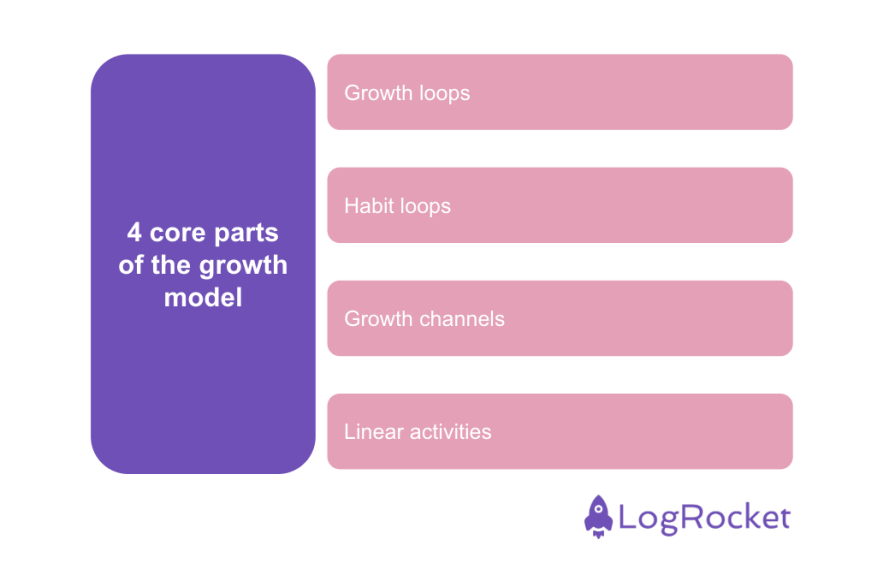One of the things that differentiates a seasoned senior product manager from a regular one is the strategic approach they take. An established PM doesn’t just look at features and optimizations, but develops and iterates on the whole product strategy.

But how do you reach this level of product management maturity?
One of the steps of the journey is understanding, conceptualizing, and iterating on the bigger picture of the product. In this article, you’ll learn what a growth model is, some of the most common ones, and how you can implement them into your role as a product manager.
In simple terms, a growth model answers the question, “how does your product grow?”
Understanding the growth model of your product helps you:
Yet, as straightforward as it might sound, it’s actually tricky to elicit a coherent answer. Just ask around in your company. Odds are you’ll receive a variety of different answers, depending on who you ask.
That’s why we need a consistent and methodological approach to answering this question. One of the approaches is differentiating four core parts of the growth model:

First and foremost, you need to define what growth really means. What one metric is the best indicator of whether the product is growing, stagnating, or declining?
Growth output is usually a combination of your retention and engagement metrics. After all, growing the user base is pointless if those users are unengaged and uninterested in the product.
Let’s take Pinterest as an example. The most common usage of Pinterest is weekly, so the retention metric would be weekly active users.
There are numerous engagement actions users can take on the platform, such as,
However, you need to define a single one. For Pinterest, it would likely be re-pinners (as that is how they also grow their SEO presence).
Combining both retention and engagement metrics, your growth output comes as weekly active repinners.
The second part of the growth model is understanding how the product turns new users into engaged and retained users.
Products build long-term engagement in users by mechanics called habit loops.
The organic way users establish habits is a three-step loop that consists of:
Part of your growth model is to enhance this loop. You can achieve it by establishing supplementary manufactured and environmental loops.
Manufactured loops help reinforce the habit by adding an additional, product-specific trigger. For example, Pinterest sends notifications to users whenever something is added to the board or theme they follow. It’s a manufactured trigger that brings users back to the product and maximizes the chances of them becoming frequent re-pinners.
Environmental habit loops help reinforce the habit by reminding users about the product in the context in which they are most likely to use an alternative solution. For example, Google reinforced the habit of using Google Meet as a go-to video conference tool by including it automatically in invitations.
Another part of a growth model is understanding how new users come to the product and, most importantly, how a new batch of new users leads to another batch of new users.
To sustainably and repeatedly grow your user base, you develop growth channels, also referred to as growth loop.
The four most prominent growth channels include:
Virality is all about existing users inviting more users, whether by word of mouth, invites or experiential virality.
SEO can be split into four distinct categories, depending on how the content is generated and distributed. We can distinguish:
Performance marketing is all about paid promotions, such as digital advertising, mass advertising, or out-of-home advertising.
Sales mean acquiring users by directly convincing them to join your product, whether in an outbound or inbound manner.
For sustainable and long-term growth, a product must have at least one self-sustaining growth channel. In our Pinterest examples, one of the channels would be the user-generated user-distributed SEO channel:
Last but not least, there are linear growth activities. Whereas growth channels are sustainable acquisition strategies, linear activities are one-time-off strategies that help you temporarily boost the user base.
Examples of these activities include:
Although linear activities are not an essential part of a growth model, they help the product grow in two ways.
First, they feed your growth channels. For example, organizing a conference is a great way to get extra leads to support a sales growth channel.
Secondly, they help you get activation energy to put some channels in motion. For example, for a vitality growth engine, you first must have a solid user base.
Now that we have learned how to map out a growth model, let’s discuss why it’s worth doing so. There are numerous benefits of a transparent and detailed growth model.
A visual representation of a growth model is a perfect conversation starter on the future of the product.
Is the current growth model optimal? Should you invest in developing new growth channels or habit loops? Does the monetization model complement the model? How should the model look in 10 years to still be relevant?
If one of your career goals as a product manager is to become more strategic, start mapping out the growth model. It will help you unlock completely new ways of thinking.
Communication becomes significantly easier when the team has a shared understanding of the product growth model. It helps to avoid misunderstanding when two people talk about the same thing but just use different words and it also helps make communication more efficient.
For example, thanks to a shared understanding of a growth model, I can leave my designer feedback such as “do you think we could revise this idea to better complement our commenting habit loop?” and we can immediately jump into the ideation phase without the need of me explaining what exactly I mean.
A growth model is a great tool for evaluating new ideas and pitches. Instead of just looking at micro-data, such as metrics the idea is trying to improve, you can take a step back and evaluate how it fits the bigger picture.
Does it align with your growth model, expand it, or contradict it? How can the idea be improved to work better with the current growth engine?
Those questions would be hard to ask and answer without a clearly map growth model.
Regardless if you’re a director of product who’s looking for the next strategic bet, or a junior PM who’s still focused on single features, I strongly encourage you to try to map out your product’s growth model.
A growth model will give you a new, holistic view of the whole product and everything that’s happening across the organization, which will, in turn, help you make better decisions and become a valuable participant in strategic discussions.
But most importantly, every product manager should be able to clearly answer the question of how their product grows, and the growth model gives you the perfect answer.
Featured image source: IconScout

LogRocket identifies friction points in the user experience so you can make informed decisions about product and design changes that must happen to hit your goals.
With LogRocket, you can understand the scope of the issues affecting your product and prioritize the changes that need to be made. LogRocket simplifies workflows by allowing Engineering, Product, UX, and Design teams to work from the same data as you, eliminating any confusion about what needs to be done.
Get your teams on the same page — try LogRocket today.

A practical framework for PMs to use AI in ideation without sacrificing judgment, strategy, or decision quality.

A practical five minute revenue estimation method to help product managers compare ideas, drop low impact features, and prioritize smarter.

A practical guide for PMs who want to stop being bottlenecks, delegate smarter, and lead teams effectively with a clear ownership framework.

Stop letting unreliable data block features. Treat data as inventory to track quality, ownership, and ship with confidence.